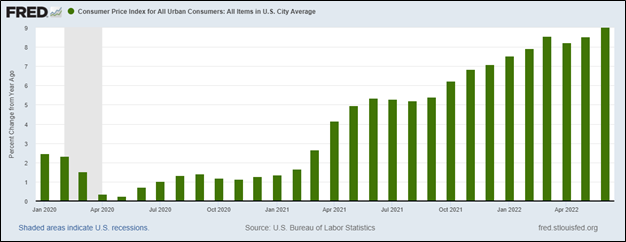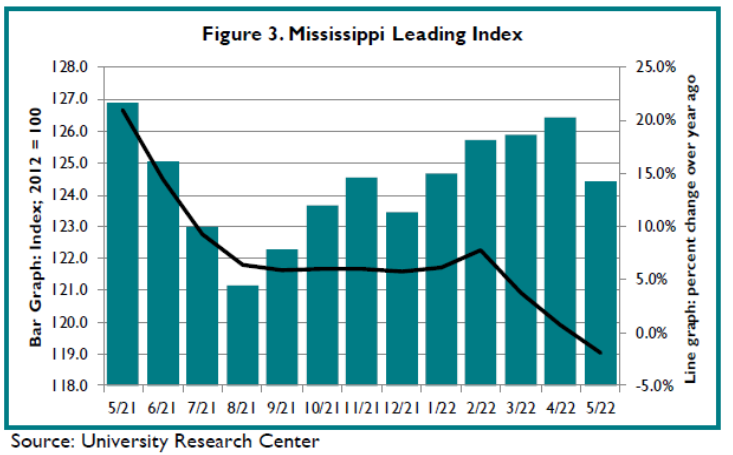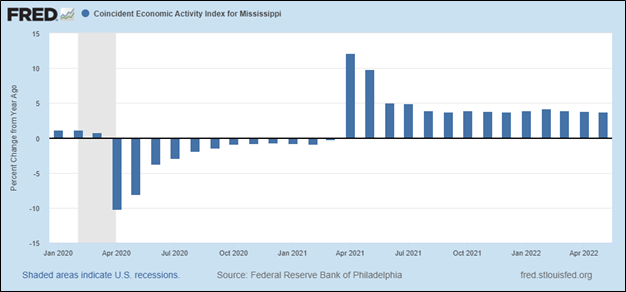USM College of Business and Economic Development Faculty Member Weighs in on Inflation with Southern Miss Now
Mon, 07/18/2022 - 02:21pm | By: David Tisdale
 Southern Miss Now recently visited with Dr. Chris Smith, a visiting assistant professor
in the University of Southern Mississippi (USM) College of Business and Economic Development,
to talk about the challenges Americans are facing with record inflation and the accompanying
high prices for a variety of goods and services, including food and gas. He shared
his insights on these and other inflationary impacts on consumers in south Mississippi
and across the country, what may be on the economic horizon, and how to manage inflation’s
effects.
Southern Miss Now recently visited with Dr. Chris Smith, a visiting assistant professor
in the University of Southern Mississippi (USM) College of Business and Economic Development,
to talk about the challenges Americans are facing with record inflation and the accompanying
high prices for a variety of goods and services, including food and gas. He shared
his insights on these and other inflationary impacts on consumers in south Mississippi
and across the country, what may be on the economic horizon, and how to manage inflation’s
effects.
Inflation has recently hit its highest level in 40 years. Many consumers are experiencing this when they go to pump gas. How else is inflation impacting consumers?
The acceleration in price inflation shown in recent economic data has been stunning if not altogether surprising. Bureau of Labor Statistics has reported that inflation for all goods and services, as measured by the change in the Consumer Price Index (CPI) in the twelve month period ending in June 2022, reached 9.1%, the largest increase measured since 1981.[1] Even when excluding food and energy items, core CPI inflation grew by a torrid 5.9% over the same period. Of course, the energy and food prices cannot be easily sidelined. Energy products have played a vital role in the inflation story, surging by 41.6% over the past 12 months and punctuated by a huge 7.5% spike during the month of June 2022 alone.[2] Overall food prices also have risen by an impressive 10.4% year-over-year, and 1% month-over-month.

Inflation is also affecting people in other ways. The CPI report also indicates that, between January 2022 and June 2022, significant price growth occurred in a diverse array of non-energy product categories like poultry (11.2%), eggs (20.9%), milk (12.1%), baby food (11.6%), coffee (6.7%), housekeeping supplies (5.7%), motor vehicle repair (7.0%), new vehicles (3.3%), hotels and motel lodging (6.0%), health insurance (10.7%), airline fees (52.5%).[3]
Not all is bad news for consumers. Prices have fallen for some goods and services categories, such as information technology products (such as computers, software, and smartphones) (-6.0%), video and audio products (-4.7%), used cars and trucks (-1.1%), sporting event tickets (-8.7%), wireless telephone services (-0.7%), beef products (-2.9%).[4] Although falling prices for these such items may offer opportunities for bargain shopping, they also likely indicate a growing trend in the reduction of consumer discretionary spending on non-essential and luxury items, a predictable consequence of an inflationary economic environment.
Home buyers and renters also have experienced powerful inflation effects. U.S. single family home prices grew by 38% between April 2020 and April 2022. This year alone prices have increased by 5% between January and April 2022.[5] This price escalation has been spurred by a rapid and steady decline in 30-year mortgage loan rates, which reached an historic low average of 2.7% in December 2020, according to research by Freddie Mac.[6] Prices have been amplified by an historic housing supply shortage, which is the result of a historically large cohort of first-time home buyers driving a boom in home sales.[7] The surge in homes since 2020 has added pressure to an already strained supply which home builders and sellers, facing COVID-19 restrictions, labor shortages, and foreclosure moratoriums have struggled to increase.[8] Rental prices have also been affected by inflation. According to the BLS CPI, rental prices for a primary residence rose by 3.0%, and the homeowner’s equivalent of rent rose by 2.7%, during the first half of 2022.[9]
One of the most important consequences of the escalation in inflation has been downward pressure on workers’ earnings. According to BLS, real average hourly earnings for all employees declined by a full percentage point between May and June 2022, and by 3.6% between June 2021 and June 2022.[10]
In the past three months, the Dow Jones Industrial Average has lost more than 10% of its previous value. Why is this happening?
The first six months of 2022 have been one of the worst such periods for the major stock market indices in recent memory. For example, the S&P 500 Index’s 20.6% decline between January 1st and June 30th, 2022, marked the worst performing first-half of a year since 1970.[11] This decline has accelerated in recent months: while the S&P 500 declined by 5.5% during the Q1 2022, it declined by 16.4% during Q2. Similarly, the Dow Jones fell by 11.6% percent during Q2 2022, despite falling by merely 4.8% in Q1 2022.
Four factors are contributing most to the decline in the equity markets. First, expectations of both rising inflation and aggressive raising of the Federal Funds Rate by the Federal Reserve in response seem to have convinced investors that stocks will generate less returns than they have in the recent past. This conclusion is supported by the recent inversion of the yield curve for U.S. treasuries.[12] Typically, the yield curve inverts with expectations of eroding economic conditions and rising short-term interest rates.
Second, the exceptionally low unemployment rates throughout the U.S., traditionally a sign of strong labor demand and high industrial capacity utilization, have been accompanied by labor shortages, which have been a key driver of supply shortages and greater supply chain inefficiencies.[13] Third, the Russian invasion of Ukraine has further disrupted global supply chains of commodities. Most notably, it has contributed to a surge in global oil and gas prices, as bans on the trade of Russian oil and gas supplies NATO-aligned countries has reduced the supply available on open markets. It has also contributed to global shortages of grain and other agricultural commodities, affecting countries in Europe, Africa, and the Middle East.
Fourth, consumer confidence has shown signs of waning. While consumer confidence was high earlier in the year, recent measurements have shown that consumers now expect economic conditions to worsen, and they place significant blame on inflation. The June 2022 University of Michigan Survey of Consumers found its index of consumer sentiment reached an all-time low, while expectations for future economic conditions reached the highest level seen since the days of the Global Financial Crisis in 2009.[14] Investors expect consumers to reduce their spending as a result, which will impact corporate earnings.
Out of concern about inflation, the Federal Reserve has recently raised its interest rate by 0.75%, the most since the early 1990s. Who will be the winners and losers of this action?
To some extent, all of us win and lose when interest rates increase. That is because, on one hand, rising interest rates increase the price of borrowing and holding debt. A higher cost of capital reduces the availability of liquidity for business investment and consumer spending, which leads to lower economic growth, a loss of jobs, and even recession. On the other hand, rising interest rates are a confidence-boosting sign that the fight against inflation has begun and that the excess liquidity that had fueled bubble-like conditions in some asset classes will be eliminated. Rising interest rates are a sign that inflation risk is ebbing, and better market conditions are on their way (eventually).
Yet some will win or lose more than others. Those using debt to purchase real estate, automobiles, or retail consumer products will find it more expensive to do so than in the past because of higher interest payments. Holders of long-duration bonds, like retirees, also may find rising interest rates to be bad for the value of their holdings. More optimistically, higher interest rates offer more incentive for those with cash flow to save it, and they also make lending more profitable.
The Federal Reserve’s efforts to manage inflation will play a key role in determining outcomes for consumers and producers. Federal Reserve has not only raised rates, but freely offered the possibility of another rate hike in the future.[15] The Federal Reserve’s Open Market Committee’s (FOMC) June 2022 dot plot – which plots the expectations of individual committee members– indicated that its members now expect interest rates to rise to 3.4% by the end of 2022.[16] On a quarterly basis, 3.4% would be the highest Federal Funds Rate since Q4 2007. The FOMC also now projects that GDP will increase by 1.7% for 2022, more than 1% lower than their March projection. Additionally, the Fed will be implementing quantitative tightening (which means scaling back asset purchases instituted during the height of the pandemic to help businesses and the larger economy).[17]
Indeed, Fed Chair Powell admitted to the Senate Banking Committee during June 2022 testimony that raising interest rates could induce a recession.[18] Powell suggested that global events have made it more difficult to reduce inflation while maintaining growth. Members of the Committee questioned Powell in ways that highlighted the dilemma facing the Federal Reserve in balancing the risks of inflation and the risks of recession. Powell argued to the Committee his belief that it is important to reduce inflation to “have a sustained period of strong labor market conditions that benefit us all.”[19] Expressing a contrasting view represented even by some members of the Federal Reserve, U.S. Senator Elizabeth Warren stated to Chair Powell, “You know what's worse than high inflation and low unemployment? It is high inflation and a recession with millions of people out of work.”[20]
The debate about who wins and loses from rising interest rates will intensify in coming months.
What will be the impact on South Mississippi?
The south Mississippi economy already feels the effects of inflation. According to the June 2022 BLS CPI report, the East South Central region of the United States (which includes the State of Mississippi) experienced price inflation of 1.1% between April and May 2022 (and 4.4% year-to-date).[21] For Q1 2022, price inflation in the East South Central region exceeded personal income growth in Mississippi, 2.6% versus 2.5%.[22] This means, in real terms, Mississippians experienced decreasing wages during the first three months of the year, and that came before the acceleration in inflation during April and May. Inflation is showing up in South Mississippi home prices as well. According to Redfin.com, whereas the statewide average price for the sale of a single-family home grew by 7.5% between January and May 2022, in Gulfport and Biloxi, home sales prices grew by 13.1% and 9.1% respectively.[23] Statewide, home sales prices increased by 7.5% during the same period.[24]
Although Mississippi has not been shielded from the effects of inflation, in some respects it may be experiencing less of a pinch from inflation than other places. For example, according to AAA.com, which provides statewide gasoline price averages updated daily, Mississippi and Louisiana have the third and fourth lowest prices, respectively, for regular gasoline prices and diesel fuel in the United States, as of July 6, 2022.[25] Their prices are 9-10% below the national average.

Other economic indicators suggest the Mississippi economy is beginning to show signs of noticeably slower growth. The Mississippi Leading Index (MLI) for May 2022, a composite economic indicator calculated and published by the University Research Center of the Mississippi Institutions of Higher Learning, fell by 1.6% month-over-month, the largest drop in over a year.[26] Six out of seven of the components of the MLI showed unfavorable trends for May, including a 17.3% increase in state initial jobless claims and a 4.6% decrease in filings for residential building permits. [27]
However, in context, May’s disappointing economic news does not appear to be so dramatic. The Coincident Economic Activity Index for Mississippi, which is published by the Federal Reserve Bank of Philadelphia, indicates that economic conditions have been steady since the middle of last year. Although inflation will likely affect this trend in coming months, how much is still up for debate.

Additionally, the rise in inflation may boost some regional industrial prospects. The South Mississippi agricultural producers may benefit from rising prices. The U.S. Department of Agriculture reports that prices received on agricultural items grew by 23.1% between January and May 2022, while prices paid on all agricultural products rose by 6.4% during the same period.[28]
Moreover, the World Bank released a Commodity Markets Outlook report of April 2022 found that global energy prices have experienced their largest growth spike since 1973 and food commodity prices increased the most since 2008.[29] The World Bank concluded the global economy suffers from a global commodity supply shock the short-to-medium term risk of which is stagflation (or, low-growth inflation). The World Bank projects Brent Crude oil will average $100 per barrel for 2022, an increase of 40% above 2021 prices. It also expects natural gas prices to increase by 100% and coal prices to increase by 80%. These conditions seem likely to benefit Gulf Coast energy producers.
What can consumers and small-business entrepreneurs do to adapt to the new economic environment?
Anyone on a budget should start by looking at how they can reduce their own costs. That can include eliminating expense items or simply cutting back spending altogether. One way to spend less is to look for deals or to explore cheaper alternatives to more expensive name brands. Second, if consumers with the means, think about paying down credit card debt. Recent data from Bank of America show a rise in consumer credit card spending.[30] Heavy credit card use during a period of high inflation presents the risk of rising interest payments. Paying down your credit cards now can help to limit exposure to higher credit card payments. Third, keep an eye out for promising investment bargains. The contraction in the markets has left many tradeable assets underpriced. Now is a wonderful time to shop for investments with good fundamentals with the aim of holding them until the market turns around.
[1] https://www.bls.gov/news.release/cpi.nr0.htm
[2] ibid
[3] Ibid, Author’s calculations based “Consumer Price Index for All Urban Consumers (CPI-U): U.S. city average, by expenditure category, June 2022” dataset. Not seasonally adjusted.
[4] ibid
[5] https://www.fhfa.gov/DataTools/Downloads/Pages/House-Price-Index.aspx
[6] https://www.freddiemac.com/research/insight/20220609-what-drove-home-price-growth-and-can-it-continue
[7] ibid
[8] ibid
[9] https://www.bls.gov/news.release/cpi.nr0.htm
[10] https://www.bls.gov/news.release/realer.nr0.htm
[11] https://finance.yahoo.com/quote/%5ESPX/history; https://www.cnn.com/2022/06/30/investing/sp-500-superlatives/index.html
[12] https://www.reuters.com/markets/us/us-yield-curve-inverts-again-what-is-it-telling-us-2022-07-05/
[13] https://www.fas.usda.gov/data/ukraine-conflict-and-other-factors-contributing-high-commodity-prices-and-food-insecurity
[14] http://www.sca.isr.umich.edu/
[15] https://www.ft.com/content/4ee276cf-8a5d-4aea-88bc-0c7c34bf96fc
[16] https://www.federalreserve.gov/monetarypolicy/files/fomcprojtabl20220615.pdf
[17] ibid
[18] Washington Post (Fed chair acknowledges that higher interest rates could cause a recession, June 22, 2022)
[19] https://www.washingtonpost.com/us-policy/2022/06/22/powell-inflation-congress/
[20] https://www.npr.org/2022/06/22/1106735608/powell-says-recession-a-possibility-but-not-likely
[21] https://www.bls.gov/web/cpi/cpipress4.xlsx
[22] https://www.bea.gov/sites/default/files/2022-06/spi0622.pdf
[23] https://www.redfin.com/us-housing-market
[24] ibid
[25] https://gasprices.aaa.com/?state=US
[26] http://www.mississippi.edu/urc/downloads/business/0722msbs.pdf
[27] ibid
[28] https://downloads.usda.library.cornell.edu/usda-esmis/files/c821gj76b/5h73r243b/7m01cs407/agpr0622.pdf
[29] https://www.worldbank.org/en/news/press-release/2022/04/26/food-and-energy-price-shocks-from-ukraine-war
[30] https://business.bofa.com/content/dam/flagship/bank-of-america-institute/economic-insights/consumer-checkpoint-july-2022.pdf